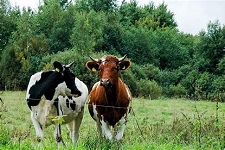HENOK TADELE HAILE – Dutch dairy farmers are renowned across the world, both in terms of the quality and quantity of milk produced. However, since 2019 they are increasingly unhappy due to their government’s plan to halve the country’s livestock sector. Whereas, Ethiopia, with plenty of land, and better investment climate with less regulatory bottlenecks, is so trusty of milk that its population only drinks an average of 19 liters of milk a year. Bringing the Dutch farmers to Ethiopia will solve both countries’ problems.
Here is why: In a bid to meet tough EU greenhouse gas emissions targets, protect biodiversity and limit agricultural pollution in the Netherlands, the Dutch government has come up with a policy to halve the country’s livestock sector by a third.
Hence, to reach the target, and protect biodiversity in the polluted countryside, the Dutch government is aggressively working to reduce the overall nitrogen, ammonium, methane, Phosphates and nitrous oxide emissions by 2030.
According to the farmers’ estimate, the government’s plan over the next ten years will decrease the number of dairy farms in the Netherlands by 33 percent, from 16,000 in 2018 to approximately 10,600 by 2030.
The Dutch government is also planning to buy up and shut down almost 3,000 farms in a bid to meet tough EU greenhouse gas emissions targets. According to Wageningen University’s economic model, as a result of the government policy, the number of dairy cows will fall to just under 1.5 million over the next ten years.
There is a genuine fear that the government cap of on-farm emissions of nitrogen and phosphate will limit farmers’ ability to grow their operations.
Hence, the government’s plan has seriously infuriated Dutch farmers and kept them so unhappy that, over the last three and half years, in an attempt to be heard by their governments and thwart the nitrogen law, furious Dutch livestock farmers have used their tractors to block roads and occupy public spaces and burning torches. They even dumped slurry at the home of the minister for nature.
In October 2019, thousands of Dutch farmers created 700 miles of traffic jams by driving their tractors to The Hague, the Dutch administrative capital city.
In 2000, there were almost 30,000 dairy farms in the Netherlands and 1.5 million total cows, but by 2020, there were just fewer than 16,000 dairy farms with 1.59 million total cows, according to Statista.
Wageningen University expects the trend to continue, while cow numbers are expected to decline to 1.48 million. Ethiopia is a huge country with a land area of 1,104,300 sq km, which makes it 27 times bigger than the Netherlands as the latter only has 41,543 sq km of land area.
In terms of population, with over 120 million people, Ethiopia is the second most populous country in Africa. However, its population is among the most milk thirsty in the world. An average Ethiopian only drinks 19 liters of very low quality milk, while the world standard is 180 liters a year per annum.
Compared with its neighbors, an average Kenyan consumes 110 liters of milk annually, representing an average of 300 ml per capita per day.
The reason is that the dairy sector here is very backward. Lack of knowledge and skills for hygienic production and processing of milk and dairy products are also the major concerns for the dairy industry.
Hence, the sector is fraught with seemingly endless problems across the value chain, including extremely low productivity, foodborne pathogens with potential health problems for consumers.
Poor animal health and unhygienic production environments often contribute to on-farm contamination with microbiological hazards throughout the value chain.
According to Ensure Ethiopia, an Addis Ababa University research project on the Ethiopian dairy sector, sources of contamination include milk handling equipment with unsanitary design, improper milk storage conditions, and unhygienic milk transportation.
All these challenges contribute to microbial contamination of milk and dairy products, which increases the risk of foodborne diseases including the prevalence of Salmonella enterica, high levels of bacteria, high coliform count, generic e.coli, antimicrobial resistance among others. The nutritional quality and adulterants of raw milk, pasteurized and cottage cheese are very low quality.
Cooperation between Ethiopia and the Netherlands is a key to solving both countries’ problems. Bringing the Dutch farmers to invest in the dairy sector in Ethiopia, which has a huge market for quality milk, with far less competition and minimum regulatory bottlenecks, will solve their problem. No tough EU greenhouse gas emissions targets here.
On the other hand, Ethiopia is suitable for dairy farming, as the majority of land in Ethiopia has a temperate climate due to its high elevation. Ethiopia has an elevated central plateau varying in height from 2,000 to 3,000 meters above sea level which is very suitable for dairy farming.
Hence, Dutch investment in livestock sector here will also solve Ethiopia’s dire milk shortage, address food security and improve food safety.

